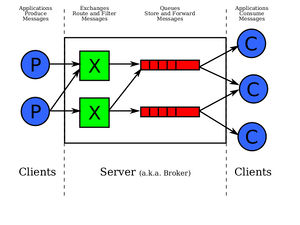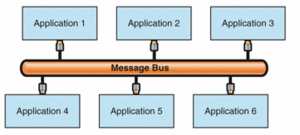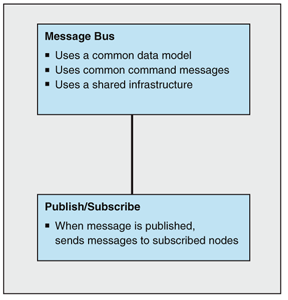Documentation/Messaging: Difference between revisions
From Commontk
Jump to navigationJump to search
PatrickCheng (talk | contribs) m (→Implementation) |
PatrickCheng (talk | contribs) No edit summary |
||
| Line 5: | Line 5: | ||
# Temporal calibration: Different components have different update frequency, a centralized manager can be used to filter UpdateEvents, so the whole system is updating at the same frequency | # Temporal calibration: Different components have different update frequency, a centralized manager can be used to filter UpdateEvents, so the whole system is updating at the same frequency | ||
==System Integration== | ==System Integration== | ||
Different system/application have different data format or are running on different physical devices. A event bus can be used for system integration | Different system/application have different data format or are running on different physical devices. A event bus can be used for system integration | ||
= | =Solution= | ||
# Use[http://msdn.microsoft.com/en-us/library/ff648849(v=pandp.10).aspx Message Broker] for event management | # Use[http://msdn.microsoft.com/en-us/library/ff648849(v=pandp.10).aspx Message Broker] for event management | ||
[[File:Amqp.jpg|thumb|none|300px|<big>AMQP model</big><br>Source: http://upload.wikimedia.org/wikipedia/en/9/9d/The-amqp-model-for-wikipedia.svg]] | |||
# Use [http://msdn.microsoft.com/en-us/library/ff647328.aspx Message Bus] and [http://msdn.microsoft.com/en-us/library/ff649664(v=pandp.10).aspx Publisher/Subscriber] design pattern for system integration | # Use [http://msdn.microsoft.com/en-us/library/ff647328.aspx Message Bus] and [http://msdn.microsoft.com/en-us/library/ff649664(v=pandp.10).aspx Publisher/Subscriber] design pattern for system integration | ||
[[File:Message bus.gif|thumb|none|300px|<big>Message Bus</big><br>Source: http://i.msdn.microsoft.com/dynimg/IC97398.gif]] | |||
[[File:Messave bus and pub&sub.gif|thumb|none|300px|<big>Message Bus</big><br>Source: http://i.msdn.microsoft.com/dynimg/IC17158.gif]] | |||
=Implementation= | |||
# Message layer: [http://www.na-mic.org/Wiki/index.php/OpenIGTLink OpenIGTLink] | # Message layer: [http://www.na-mic.org/Wiki/index.php/OpenIGTLink OpenIGTLink] | ||
#* OpenIGTLink defines many common data format and message structure | #* OpenIGTLink defines many common data format and message structure | ||
| Line 22: | Line 27: | ||
#* CMake version of library can be found here http://github.com/PatrickCheng/zeromq2 | #* CMake version of library can be found here http://github.com/PatrickCheng/zeromq2 | ||
#* API can be found here http://api.zeromq.org/zmq.html | #* API can be found here http://api.zeromq.org/zmq.html | ||
Revision as of 19:36, 27 May 2010
Home < Documentation < MessagingUse cases
Event Management
Each component/application generates many different types of events. A centralized event manager (Hub and Spoke) can be used to aggregate/dispatch events
- Synchronization: Window/Leveling events in one window should be synchronized across all viewer windows
- Temporal calibration: Different components have different update frequency, a centralized manager can be used to filter UpdateEvents, so the whole system is updating at the same frequency
System Integration
Different system/application have different data format or are running on different physical devices. A event bus can be used for system integration
Solution
- UseMessage Broker for event management
- Use Message Bus and Publisher/Subscriber design pattern for system integration
Implementation
- Message layer: OpenIGTLink
- OpenIGTLink defines many common data format and message structure
- It has plain vanilla socket support, might switch to ZeroMQ for transportation
- Transportation layer abstraction: ZeroMQ
- ZeroMQ is a small and fast implementation of the Advanced Message Queuing Protocol under the LGPL license
- It supports both synchronous and asynchronous messaging mode
- It supportsTCP, Multicast/PGM, Inter-process, and inter-thread transportation
- CMake version of library can be found here http://github.com/PatrickCheng/zeromq2
- API can be found here http://api.zeromq.org/zmq.html


